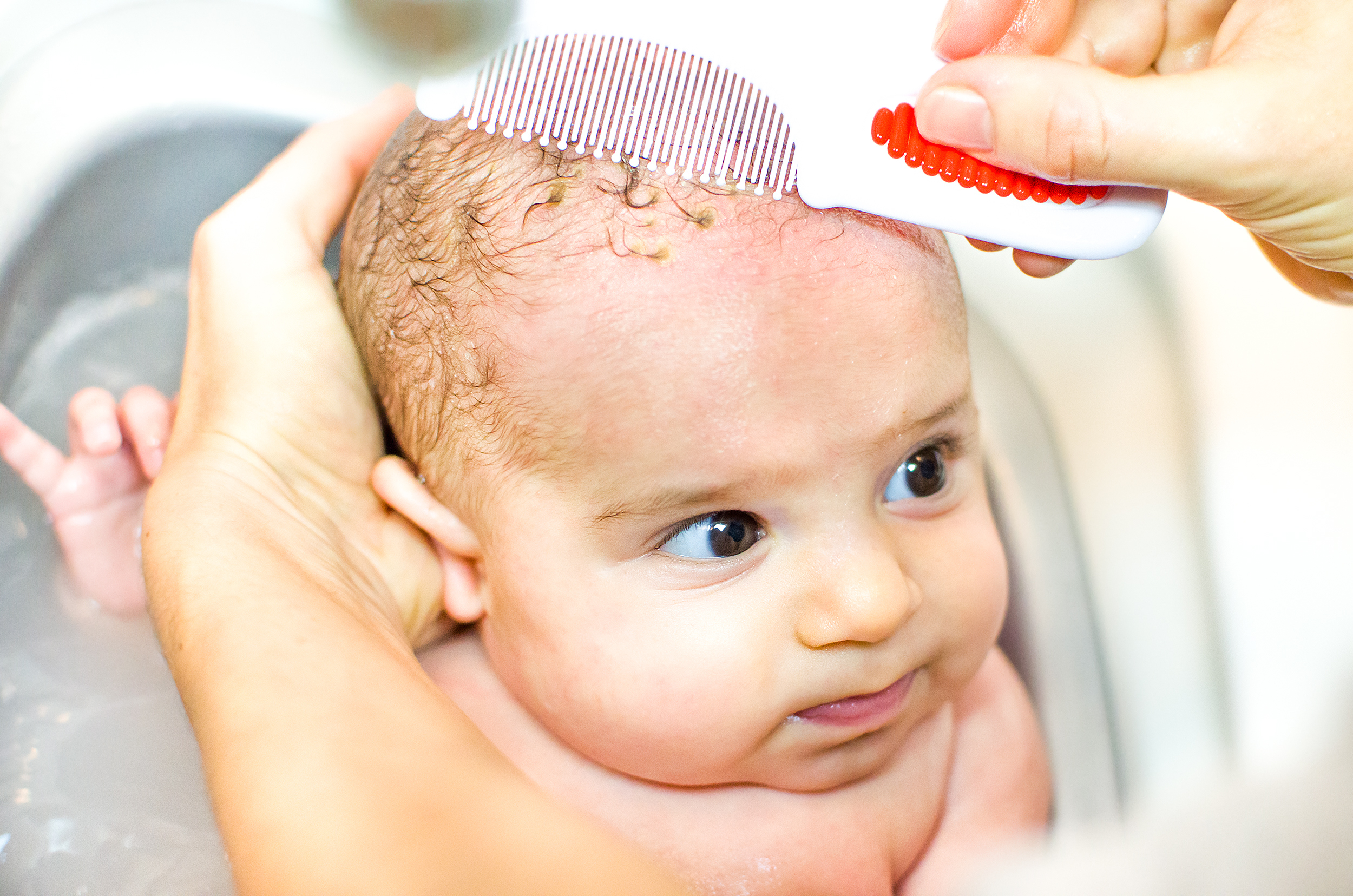-
What is Cradle Cap?

What is on your baby’s scalp?
It happens to most new parents, and it can be disconcerting. You’re snuggling your sweet new baby, inhaling that delicious baby smell, when you notice something a bit, well, icky. Red scaly or crusty yellow patches disrupt the sweet softness of your infant’s scalp, blotch your baby’s beautiful face, or appear in the diaper area. What is that? It’s cradle cap, and here’s what you need to know about it.
Cradle Cap is a Common Condition
Cradle cap is scientifically known as seborrheic dermatitis, and it can develop when a baby is between two and 12 months old. Generally, it starts on the scalp, as red or yellow patches that are greasy, scaly, or flaky, but it can also start on the face or in the diaper area, armpits, or any other place where the skin folds and creases. In creases and folds like the neck or behind the ears, it appears red and moist. It may look uncomfortable, but it doesn’t typically bother infants. Unlike atopic dermatitis, it is not itchy.
Causes of Cradle Cap
No one really knows what causes cradle cap, but it’s probably more than one thing. Oil buildup in the oil glands and hair follicles, combined with yeast found on the skin, play roles in its development. It is also thought that hormones passed along from the mother to the child before birth can contribute to the formation of cradle cap. What is known is that it is not the result of poor hygiene, and it is not contagious. A doctor can diagnose cradle cap by looking at it, and it will generally get better whether it’s treated or not. However, you might want to treat it, just to get those scales off of your baby’s scalp.
Treating Cradle Cap
Sometimes, cradle cap can be prevented with daily hair washing. Wash your baby’s scalp with a mild, tear-free shampoo, and remove the scales with a soft brush or toothbrush. If the scales are too stubborn for gentle shampoo, try a bit of baby oil, mineral oil, or olive oil, allowing the oil to soak into the scales so that you can loosen them with a soft brush. Once you’ve done that shampoo as usual. Be careful not to use any shampoos with nut oil on a child under five years of age.
Does cradle cap require a doctor visit?
If the cradle cap won’t clear up with regular shampooing, you might want to ask your pediatrician for help. He or she might recommend a mild steroid cream or antifungal shampoo, or a cream for parts of the body other than the scalp. Don’t use any over-the-counter anti-seborrhea shampoos, steroids, or antifungal creams on your baby without asking your doctor first. In some cases, seborrheic dermatitis in skin folds or the diaper area can get infected. If you notice signs of infection, like warm, red skin or fluid draining, call the pediatrician. Usually, though, cradle cap and seborrheic dermatitis clear up by 12 months of age, but may come back during puberty as dandruff.
Healthy Babies Start with Healthy Parents
At the Center for Vasectomy Reversal, we love helping people grow their families. We pride ourselves on helping men improve their fertility through uncompromising, concierge-level patient care. Under the direction of Dr. Joshua Green, our team provides state-of-the-art treatment for men who need a reversal of their vasectomy or have other fertility concerns. To learn more, contact us through our website or call 941-894-6428. For more parenting tips, click on the link to our blogs!
-
What is Parentification?

Daughter consoling stressed father.
The role of the parent and child are typically well-defined, right? The parent is the caretaker, with the child focusing all his or her energy on growing and developing. That’s the normal way of things, but sometimes, these roles are reversed, and the child becomes the caretaker. This phenomenon is called parentification, and it is detrimental to children, causing long-term negative effects on their emotional and mental wellbeing. Here, we discuss parentification, explaining what it is, why it’s not good, and how to spot the warning signs.
- What are the types of parentification? In a healthy parent-child relationship, the parent cares for the child, but parentification happens when the parent relies inappropriately on the child. The two types of parentification are emotional and instrumental.
- Emotional parentification is when the child provides excessive emotional support to the parent. Acting in the capacity of a therapist, the child listens to the parent’s troubles, reassures and soothes them, and gives advice. Children placed into this position by emotional parentification keep their parent’s secrets, comfort their siblings during conflicts, and try to diffuse negative situations. They stifle their own pain in the interest of taking care of their parents and siblings emotionally.
- Instrumental parentification involves children taking on adult responsibilities. While it is appropriate for children to help around the house, instrumental parentification occurs when children must do the weekly grocery shopping, cook, clean, manage finances, or take responsibility for their siblings in a way that serves the parent more than the children. The tasks are often beyond the child’s level of ability and comprehension. Sometimes, this parentification is sibling-focused, particularly if a child is tasked with caring for a sibling with a disability or chronic illness. To determine whether the things being asked of a child amount to parentification, look at whose needs are being met and whether the demands are age-appropriate. Doing chores and helping with younger siblings can help build a child’s confidence and abilities, but parentification is harmful to children.
- How does this happen? When the parent is experiencing physical or emotional impairment, whether it’s an addiction, a disability, or a physical or mental illness, it impedes the parent’s ability to be a reliable and predictable caretaker. Unexpected life events and financial hardship can also lead the parent to lean on a child too much, but sometimes, parentification is simply the result of neglect. Children step up to take responsibilities that are inappropriate for their age and level of development because they want to keep the family functioning.
- How is this harmful to children? Children who are parentified often suppress their own needs and emotions, discerning that there is only room for one person’s needs in their relationship. They can grow up to have problems with relationships, choosing self-centered partners because they are more comfortable with this known dynamic. They experience fear of abandonment or rejection, and they may develop mental health issues, experiencing issues like anxiety, depression, substance abuse disorders, and so on. The silver lining in all this is that children who have experienced parentification are often extremely emotionally intelligent, responsible, organized, and empathetic.
- What are the symptoms of parentification? When a child is relied upon too heavily by a parent, the child may show signs of self-doubt, difficulty being assertive, a strong desire to please other people, guilt, depression, stress, and anxiety. The child may have difficulties at school and show signs of a loss of childhood. Physical symptoms with no known source may manifest, like stomach aches or headaches, and the child may act out at school. Teenagers may use substances to self-medicate. In the long term, people who have experienced parentification may have trust issues, and they are at an increased risk of mental and physical health issues. Parentified children often become codependent adults.
- How can one overcome parentification? It can help to see a mental health professional to overcome the negative effects of parentification. While recognizing parentification and treating the child early is best, adults who experienced this phenomenon in childhood can also benefit from the help of a mental health professional. Overcoming the negative effects of parentification is especially important in helping people establish new patterns so that they can build their own healthy, happy family.
At the Center for Vasectomy Reversal, we love helping people grow their families. We pride ourselves on helping men improve their fertility through uncompromising, concierge-level patient care. Under the direction of Dr. Joshua Green, our team provides state-of-the-art treatment for men who need a reversal of their vasectomy or have other fertility concerns. To learn more, contact us through our website or call 941-894-6428.
- What are the types of parentification? In a healthy parent-child relationship, the parent cares for the child, but parentification happens when the parent relies inappropriately on the child. The two types of parentification are emotional and instrumental.
-
The Most Common Illnesses Children Face

Father taking care of sick child.
Our children are such a gift to us! Precious and adorable, they light up our lives with their sweet little faces and loving hearts. Unfortunately, they are also unbelievably germy. Any parent of a young child has no doubt had that horrifying moment when their cute little sweetheart rolls on the floor in public, picks up something off the ground and pops it right into his or her mouth, or licks a handrail. They seem determined to touch everything, and while this is just a natural part of childish curiosity, it’s also a great way to pick up the viruses and bacteria that bring on childhood illnesses. Add to this the fact that children’s immune systems are not as strong as they will be later, because they have not yet built up immunity, throw in some interaction with other children at daycare or playgroups, and it’s no wonder that some kids seem to just stay sick. It helps to know the facts about some common illnesses, so that you will know how to manage them, and which ones warrant a trip to the pediatrician. Here, we discuss some of the most common illnesses children face.
- The common cold can strike kids about five times a year. The mild fever, congestion, sore throat, and cough that come along with it should be treated with fluids and rest, and if your child is uncomfortable, you can give children’s ibuprofen or acetaminophen if your pediatrician approves. It is best not to give a child cough and cold medicines, because it’s easy to give a child too much.
- Little ones are most vulnerable to RSV. Respiratory syncytial virus is a common childhood illness that affects the lungs. Most of the time, it’s just a minor respiratory illness with cold-like symptoms like coughing, sneezing, runny nose, and fever. However, it can be extremely serious for young infants, preemies, children with compromised immune systems, chronic lung disease, or a congenital heart condition, as well as elderly adults. About 150,000 children are hospitalized each year because of RSV, so it is vital to call your pediatrician immediately if you notice your child wheezing, breathing quickly or with difficulty, refusing to drink, appearing lethargic, or starting to develop a bluish color on the lips and in the mouth.
- Roseola also impacts the smallest kids. Sometimes, this illness is so minor that it is completely overlooked. For some children, though, it leads to a high fever, congestion, coughing, and a patchy rash that starts on the chest and spreads. Fortunately, it almost always ends quickly, and usually only occurs in those younger than two years old. If your child’s fever spikes or last longer than three days, seek medical attention. Otherwise, you can treat roseola at home with children’s ibuprofen. Roseola is contagious, so keep a child with this illness home until the rash is completely gone.
- Gastroenteritis is commonly known as a stomach bug. Many different viruses can cause this illness, including norovirus, and it comes with vomiting, diarrhea, and abdominal pain. Generally, there’s not much you can do except give some TLC and encourage the child to rest until it subsides, usually within a few days to a week. Give plenty of fluids because gastroenteritis can easily lead to dehydration.
- The Coxsackievirus is also called Hand-Foot-Mouth disease. This virus, which occurs mainly during summer and fall, is extremely contagious, spread through touch, coughing, sneezing, and fecal matter. It is not particularly serious, but it is very uncomfortable, causing skin rash, fever, mouth sores, flu-like symptoms, and sometimes blisters on the hands and feet. There’s not much to do for a child with Coxsackievirus except to make him or her comfortable with ibuprofen or acetaminophen, with ice pops and non-acidic juice to ease the sore throat. Pay close attention, though, because kids often don’t want to drink due to the sore throat, and this can lead to dehydration.
- Fifth disease is also called Slapped Cheek syndrome. Most common in children three and under, it causes a bright-red rash on the cheeks, and sometimes a mild fever, runny nose, and secondary rash on the torso. It’s very contagious until the rash erupts. It subsides on its own, but if your child develops joint pain, let the doctor know, and if you are pregnant and your child develops fifth disease, talk to your ob-gyn about the risks of complications.
- Strep rarely affects small children. If a baby or toddler contracts strep throat, it’s typically because an older sibling has it. However, your child can also get strep throat through interaction with a child who has it, or even by playing with a toy an infected child has been using. Caused by the bacteria streptococcus pyogenes, strep can cause sore throat, fever, swollen tonsils, and stomach pain. Your pediatrician can run a strep test and provide your child with antibiotics.
- Influenza is the official name of the flu. Having the flu is miserable, with symptoms like headache, sore throat, high fever, cough, and sometimes even vomiting or having diarrhea. Fortunately, you can greatly decrease your child’s risk of contracting influenza through the use of flu vaccines.
- Conjunctivitis is commonly known as pink eye. It is extremely contagious, and spread through your entire household very quickly, causing redness, yellowish discharge, crusty eyes, and blurry vision. It’s very uncomfortable as well as contagious, and in young kids, almost always caused by a bacterial infection. Your pediatrician can prescribe antibiotic eye drops, and the child should be careful to wash hands and avoid sharing hand towels, wash cloths, pillows and blankets to avoid infecting others in your home.
- Pinworms are the result of poor hygiene. If you’re unfamiliar with these parasites, and they sound disgusting to you because of the word “worms,” you are on to something. Unlike ringworm, which is a fungus, pinworms are actual worms that get into kids’ digestive systems when they don’t wash their hands. These nasty little bugs move down the digestive system and lay eggs around the anus, which causes itching. If you notice your child scratching his or her bottom, talk to your pediatrician. The doctor can give you a special tape to put on the area at night and bring back in to be analyzed for pinworms and their eggs. They can be treated with a dose or two of prescription medication, but you will have to wash the towels and bedding in hot water to completely eradicate them from your home.
- Kids get more ear infections than adults do. In fact, an ear infection is one of the most common childhood illnesses. Caused by bacterial or viral infections, they cause ear pain, irritability, trouble sleeping, tugging on the ear, and a fever.
- Bronchitis often follows an upper respiratory infection. Occurring when the airways in the lungs swell and produce mucus, bronchitis causes soreness in the chest, body aches, a sore throat, headaches, and fatigue. It’s typically caused by a virus, and the best treatment is rest, fluids, and sleeping with a humidifier in the room.
- Sinusitis means a sinus infection. It’s caused when fluid builds up in the sinuses and allows viruses and bacteria to grow. It can be very uncomfortable, with runny or stuffy nose, headache, pressure or pain in the face, sore throat, cough, bad breath, and post nasal drip, but should resolve on its own.
At the Center for Vasectomy Reversal, we love helping people grow their families. We pride ourselves on helping men improve their fertility through uncompromising, concierge-level patient care. Under the direction of Dr. Joshua Green, our team provides state-of-the-art treatment for men who need a reversal of their vasectomy or have other fertility concerns. To learn more, contact us through our website or call 941-894-6428.
-
How Long Should You Wait Between Pregnancies?

New parents discuss having more children.
How close together would you like to have your children? Is it better to have them close together, so that you can get through the diaper stage all at once, or to spread them out so the older ones can help with the younger ones? If you have waited to start a family, do you have time to have more than two children? How far apart you space your children is a subjective decision, of course, but medical science does have some guidelines to offer. Beyond that, there are pros and cons to consider, no matter which way you’re leaning.
According to the World Health Organization (WHO), women should wait between 18 and 24 months between pregnancies. However, recent research published in JAMA Internal Medicine, women only need to wait a year between a birth and another pregnancy. A smaller gap than that can increase risks to the mother and baby, and the new findings indicate that waiting 12 to 18 months is optimal. This is great news for women over 35, who might be concerned about having more children as their maternal age advances. It’s important to wait at least 12 months between pregnancies, though, because becoming pregnant sooner than that increases the risk of maternal mortality, no matter the age of the mother. The risk is lower still at 18 months, so weigh this carefully when spacing your children.
Getting pregnant too quickly in succession is also risky for the baby. It increases the odds of premature birth, low rate, and small gestational age, all of which increase the risk of long-term health problems. Closely spaced pregnancies also have a higher risk of placental abruption, which results in a higher risk of fetal mortality and stillbirth.
Aside from the health of mom and baby, there are several other factors that you should consider when determining how far apart to space your pregnancies.
- How much of a gap do you want to have between your children? There is something to be said for having children who go through similar stages at the same time. They can share toys and gear, are likely to play together nicely, and as mentioned earlier, you can get through the diaper stage more quickly. On the other hand, being able to spend time alone with your newborn while your older child is in preschool is helpful. Having a “big” sibling who can help out with minor tasks, like bringing you a burp cloth or a new pack of wipes, can also be a boon.
- Consider your living space. Is there enough space for your children to have separate rooms? Will your older child be using the crib when your little one arrives? Will your children need to share space? Think about how you will situate the kids, along with any challenges you’ll face in the near future, like a move, that could make having a baby any time soon inconvenient.
- Think about the expense of a new baby. One benefit to having kids close together is that they can share much of the gear, and your older one will likely have hand-me-downs to pass along to the new baby. Consider, however, the expense of things like diapers and childcare, and make sure that having another child won’t put your family into a financial disadvantage.
- How do you feel about having another baby? Are you ready? Talk to your spouse so that you’ll know you’re on the same page. Your mental health and your instincts are both important, so trust your gut on whether or not this is the right time to bring another little person into your family.
The bottom line, of course, is that planning the spacing of your family is intensely personal. At the Center for Vasectomy Reversal, we love helping people grow their families. We pride ourselves on helping men improve their fertility through uncompromising, concierge-level patient care. Under the direction of Dr. Joshua Green, our team provides state-of-the-art treatment for men who need a reversal of their vasectomy or have other fertility concerns. To learn more, contact us through our website or call 941-894-6428.
-
How to Avoid Spoiling Your Kids

Parents playing with child.
They come into the world so little and sweet, and before you know it, your babies are turning into toddlers. Until now, it’s been pretty easy to manage them, but suddenly, they’re little people with minds of their own. You love them, you’d do anything for them, but how do you avoid spoiling them? We’ve got some tips to help you raise kids who are happy, secure, and definitely not spoiled.
- Set boundaries and stick to them. Being consistent is one of the most important parts of being a parent. Make sure the rules are clear, and use discipline strategies that work for your child. Remember, discipline needn’t be punitive. Try positive disciplinary practices like redirection and positive reinforcement. Expect your children to push your boundaries, it’s a normal part of child development, but resist the urge to cave when they do. It’s important to stick to your limits, or you could end up with a child who second guesses you at every turn. Teach your children that the rules are the rules, no means no, and there are consequences for bad behavior.
- Assign chores from an early age. Give your little ones age-appropriate chores, like putting away toys, setting the table, and putting plastic dinnerware in the sink. This will encourage your child to think about the needs of others, as well as instilling a sense of responsibility. Make it a rule that chores are done before fun; research indicates that children whose parents are strict about chores are better able to cope with frustration.
- Encourage good manners. Please and thank you should be some of your child’s first words, and saying thank you should become something your child does reflexively, without prompting. Good table manners, too, help a child become someone people want to be around. Teach your child to share, take turns, and respect the feelings of others, and not to be a sore loser or call names. Be a good example by being polite to the people you encounter in daily life, and teach your children how to write thank you notes to people who do nice things for them or give them gifts.
- Allow your little one to experience disappointment. Disappointment is a part of life. While it’s tempting to try to protect your child from the negative aspects of life, overprotecting can result in a spoiled child. Whether it’s a canceled playdate or not getting something he or she wants when you’re at the store, learning to face disappointment at an early age will serve your child well in the long run and help to develop coping skills.
- Foster compassion and a giving spirit. Make it your goal to raise a child who considers the needs of others and is compassionate and generous. Model this behavior by volunteering as a family, donating to charities, and letting your child see you being kind and giving to others. Children who put the needs of others first are less likely to be spoiled.
- Don’t give too many chances. We’ve all heard parents counting “2 ½ “, “2 ¾ “ before getting to three, and this is something to avoid if you don’t want spoiled kids. Failing to follow through on what you’ve said is going to happen, or dragging it out, can teach your children that they can manipulate you- and other people- to get what they want.
- Give kids the opportunity to work for what they want. Allow your child to make a case for the things he or she wants. If it’s watching a tv show, your child can explain the chores that have been done or offer to take a nap first. You can also let your children earn material things, like toys, through good behavior. To do this, set up a reward system to make your expectations clear.
- Don’t negotiate with terrorists… or toddlers. If your children think they can behave badly to get the things they want, they will do it. Don’t offer treats to squelch unpleasant behavior, or your child will expect every tantrum to end with a prize. Similarly, refrain from giving in to begging.
- Say yes whenever you can. If you’re always saying no, your children might begin to think you say no to everything, and this can lead to them thinking that bad behavior doesn’t matter, since they won’t get what they want anyway. Choose your battles, treat your child with kindness, and reward good behavior.
At the Center for Vasectomy Reversal, we love helping people grow their families. We pride ourselves on helping men improve their fertility through uncompromising, concierge-level patient care. Under the direction of Dr. Joshua Green, our team provides state-of-the-art treatment for men who need a reversal of their vasectomy or have other fertility concerns. To learn more, contact us through our website or call 941-894-6428.
-
How to Prevent Burnout as a Father

When you are a parent, it seems there’s always something you need to be doing. Whether you’re working at your job or working at home, it seems like there’s always pressure to do more. Sometimes, men fail to take care of themselves, and this can cause a dad to experience burnout. Burnout is an actual condition, and it’s been especially prevalent since the onset of the pandemic. Left unchecked, it can wreck your health, your marriage, and your friendships. How can you prevent this? Recognize that self-care doesn’t necessarily mean pampering, but it does mean taking care of yourself, so you’ll be strong enough to take care of others. Here are some tips for avoiding burnout.
- Take a timeout. Timeouts are not just for kids, they’re good for adults, too. Taking 15 minutes to take a break can help you catch your breath so that you can re-engage with your family in a better headspace.
- Get some sleep. Research shows that people who get eight hours of sleep each night are more productive. Even if you are busy, prioritize your sleep, rather than skimping on rest in order to get ahead.
- Go outside and exercise. It’s easy to feel exhausted, grumpy, and irritable if you haven’t been getting enough exercise. Something as simple as taking a walk can boost your energy and clear your head.
- Connect with your wife. Spending time with your spouse, listening to her and talking to her, can improve your relationship and strengthen your ability to work as a team. Raising a family is hectic, and you each need a partner, so make this a priority.
- Have an adventure. Try something new, whether it’s a new creative hobby or an epic outdoor adventure spent kayaking, rock climbing, surfing, or deep sea fishing. You can do this by yourself, with some buddies, or take your wife and children on a fun adventure with you. The family time you spend doing something new and fun can strengthen your bond.
- Spend some time in quiet reflection. Learn to meditate, institute a daily prayer routine, or simply sit each day or a few minutes and quietly ask yourself a few questions. Think about something you recently learned, pick words to describe your week, identify your biggest challenges and wins, and think about how you can make your next week better than this one. Think about your priorities or identify areas of stress. It doesn’t really matter what you think about, as long as you are alone with your thoughts for a little while.
- Make time to hang out without kids. Don’t neglect your social life just because you have kids. Spend time out with friends, and spend time out with your wife, remembering who you used to be before you were a dad.
At the Center for Vasectomy Reversal, we love helping people grow their families. We pride ourselves on helping men improve their fertility through uncompromising, concierge-level patient care. Under the direction of Dr. Joshua Green, our team provides state-of-the-art treatment for men who need a reversal of their vasectomy or have other fertility concerns. To learn more, contact us through our website or call 941-894-6428.
-
How to Throw a Children’s Birthday Party on a Budget

Children’s birthday parties are a beloved part of childhood, a time honored tradition, and with good reason. It’s natural to want to celebrate your little one, marking every milestone, and birthdays are a natural cause for celebration. These days, however, it’s easy to let a birthday party get out of hand. Whether you get carried away with the excitement of celebrating your child or you’re trying to keep up with the Joneses, before you know it, your budget is out the window. It doesn’t have to be that way, though. We have some great tips for throwing an amazing birthday party while sticking to your budget.
- Don’t feel pressured to throw a party every year. When kids are little, birthdays mean more to the parents than they do to the children. Consider taking your little one on a fun outing, rather than spending money on a party that won’t even be remembered. You might also think about having a birthday party every other year, and doing something special with a friend or the family on the alternate years.
- Keep parties small and intimate. You do not have to invite the whole class or even the whole soccer team to your child’s birthday party. It’s much more manageable to keep the guest list under 10 children. In fact, one good rule of thumb is to invite one child for every year of age. For a five year old birthday party, five kids is plenty.
- Be smart about timing. Don’t plan your parties for mealtime, when you’ll have to put out a whole spread. Instead, choose a time in between meals, when some simple snacks and a birthday cake or cupcakes will suffice.
- Make as much as possible yourself. Make your own invitations, either by hand, if you’re crafty, or digitally, if you’re not. There are plenty of cute invitations online, and it won’t cost you anything to send them via email. You can make your own cake or cupcakes, too, and if you want a themed cake, head to a cake decorating store and pick up some cheap decorations to stick on it. Putting together your own snacks and making your own decorations can also cut down on costs.
- Take advantage of available resources. Check out books or a DVD from the library to entertain the kids. Find some printables online that you can print out for free as a fun activity or decoration. Use things you already own to support your party theme. (Hint: pick a theme for which you know you already have supplies!) Borrow equipment if you want to do something special, like a backyard movie.
- Shop early for the best deals. Sites like Oriental Trading Company have great deals on party favors and décor, but you can’t order at the last minute. Plan ahead a little bit, and you will be surprised how much money you can save.
- Pick a party location that’s free. Your house is a great example, but if you don’t feel like your house is suitable for hosting, take some time to think about other free options. It might be a park, the beach, your subdivision’s pool, or a neighbor’s house, but you’re likely to find somewhere that will work perfectly. If not, look into cheap options like the local rec center.
- Provide an activity that doubles as a favor. Let kids do a craft or decorate cookies or cupcakes, then take those treasures home. This is cheaper than filling a goody bag, and the parents will thank you when there are not so many plastic trinkets floating around their houses.
- Choose classic games for simple fun. Old school games like musical chairs, hot potato, four square, duck duck goose, or red rover are big hits with young kids, and they don’t cost a thing. Not quite sure of the rules? Look for game instructions online.
At the Center for Vasectomy Reversal, we love watching people enjoy their families. We pride ourselves on helping men improve their fertility through uncompromising, concierge-level patient care. Under the direction of Dr. Joshua Green, our team provides state-of-the-art treatment for men who need a reversal of their vasectomy or have other fertility concerns. To learn more, contact us through our website or call 941-894-6428.
-
How to Teach Your Kids About Sun Safety

Parents have many important jobs, and one of them is to teach children about safety. We educate our kids on everything from eating healthy foods to safely crossing the street to protecting themselves from stranger danger. With all you need to teach your children about the dangers of the world, has sun safety made it into your lesson plan yet? It really should be one of the first things you teach, because protecting them from the sun early in life and teaching them to do it for themselves will go a long way in helping to keep their skin healthy for the rest of their lives. Here are some helpful tips for teaching your kids about sun safety.
- Teach them about the tools they’ll need for sun protection. It starts with sunscreen, of course, but sun protection goes further than that. Sun protective clothes and hats can provide help, and sunglasses can protect from the damage UV rays can do to the eyes. Teach kids to seek out natural shade or sit under an umbrella to help reduce their sun exposure.
- Explain how to apply sunscreen. Because it doesn’t work as well when it’s not properly applied, make sure your kids know that sunscreen needs to be slathered on, and buy products that are easy for them to apply, even without your help. Teach that wet or sweat means re-apply, and that sunscreen should be re-applied every two hours, even when they aren’t swimming.
- Talk about timing. Sun protection is great, but kids also need to know that UV rays are at their strongest between 10 am and 4pm. One way to make this concept come alive for kids is to play the shadow game. Have them look for their shadows, and explain that if they’re short, that means the sun is higher and stronger. Whenever they have short shadows, they should find a shady spot in which to play. The longer their shadows become, the more they can expand their play area.
- Give them reasons not to tan. As kids get older, your kids may become interested in tanning. According to a study by the American Academy of Dermatology, 63 percent of teenagers think they look better with a tan, 59 percent believe that people look healthier when they are tan, 43 percent of teenagers lie out in the sun to get a tan, 28 percent of female teens and 14 percent of male teens say they do not use sun block. Only 30 percent of teens say they use sun block when they lie out in the sun. Teach your kids that tanning is a sign of skin damage, and tanning beds are especially hazardous. If they insist, buy some tanning lotion so that they can safely tan their skin.
- Set a good example. If you want kids to wear sun screen every single day, they need to see you wearing sunscreen every single day. Modeling proper sun protection is the best way to teach your children that sun protection is important.
- Make sun protection fun. Let your little ones choose their own hats, sun glasses, and sun protective clothing, in fun patterns that will make them want to wear these items. You can also make sunray-sensitive jewelry together, stringing ultraviolet detection beads onto a piece of leather. Tie this around your child’s wrist or ankle, and explain that when the beads change color, it’s time to put on sunscreen. Sing a song like “head, shoulders, knees, and toes” as you apply sunscreen, talking about the areas of the body that people need a little help reaching, and which ones need the most sunscreen.
At the Center for Vasectomy Reversal, we love making the world better by helping people grow their families. We pride ourselves on helping men improve their fertility through uncompromising, concierge-level patient care. Under the direction of Dr. Joshua Green, our team provides state-of-the-art treatment for men who need a reversal of their vasectomy or have other fertility concerns. To learn more, contact us through our website or call 941-894-6428.
-
Old Wives’ Tales About Childcare

There is knowledge in parenting that has been passed down through the generations. Some of this is good advice, sound, common sensical wisdom handed down from grandmother to mother to child and treasured as a gift. Some of it, however, is nonsense. Let’s talk about some things your grandmother may have passed along that are not quite right. Which as much scientific knowledge as we have in the modern era, there’s no need to cling to old wives’ tales about childcare.
- Many myths persist on the topics of standing and walking. For instance, many people believe that wearing shoes will help babies learn to walk sooner, when going barefoot is actually better. Soft-soled shoes that look like moccasins are wonderful for babies learning to walk, because they are flexible and help the baby feel the ground. Children who are walking need comfortable, flexible shoes. Another walking myth is that babies learn to walk sooner when they use a walker. Actually, baby walkers slow down a child’s progression into sitting, crawling, and walking, and are, in fact, dangerous. The American Academy of Pediatrics has even suggested a ban on walkers. A better alternative is an exersaucer.
- Let’s look at some myths about the mouth. It is commonly thought that thumb sucking causes buck teeth, but that is, in reality, not the case. Thumb sucking is natural, and often begins before birth. As long as children stop sucking their thumbs by about age four, it should not cause a problem. Thumb sucking over age five can cause buck teeth, but peer pressure usually discourages this behavior. Another common myth is that teething can cause a child to run a fever, or have diaper rash, a fever, or a runny nose. Other problems attributed to teething include sleep issues and lowered resistance to infection, but teething does not really cause any of these things. When a teething baby has some of these other symptoms, it usually indicates a virus; babies who are teething are also building immunity at the same stage.
- Myths about milestones can make new parents nervous. No, you don’t need to worry that something is wrong with a baby who gets teeth late, and feeding babies solid food early won’t help them sleep through the night. Babies who are late talkers do not necessarily have autism, and babies who are nervous about strangers when they are four to six months old are not insecure and unloved, they are going through a perfectly normal stage of development.
- We know more about environmental concerns than we did when most of these myths were started. Some people worry that taking a picture of a baby using flash photography is dangerous, but that is not true. There is also an old wives’ tale that air conditioning is bad for a baby, and another that says cats are dangerous to infants because they will steal the baby’s breath. Think about some of these concerns logically, and you will see there’s no need to worry.
- There are far too many myths about medical care. Let’s get the weirdest one out of the way first: people used to think blowing smoke into a baby’s ear would cure an ear infection by warming the ear canal. As we now know, second hand smoke raises a baby’s risk of respiratory infections and ear infections. That’s far from the only myth about taking care of a sick baby, though. Many grandparents still believe that you should treat a fever by plunging a child into a cold bath to lower the temperature or piling on blankets to “sweat the fever out.” Neither of these are good ideas, and both could actually exacerbate the illness. Treat a child’s fever with acetaminophen or ibuprofen, and see a doctor if it goes above 100.5°F in a very young baby or 104°F in an older child. Another myth is that wounds should be allowed to “air out,” but it is recommended to cover a cut or scrape to prevent exposure to contaminants. Never put butter or ice on a burn, but put the affected area under cool water to bring down the temperature and numb the area. Similarly, don’t put alcohol on a teething baby’s gums, but relieve teething pain with teething gel, teething toys, or a cool washcloth. One final old wives’ tale: that you should tilt a child’s head back if he or she is experiencing a nosebleed. A more effective option is to tilt the head forward while pinching the soft part of a child’s nose, below the bridge. This will allow blood to flow out of the nose instead of into the throat, and the nose-pinching will eventually stop the flow of blood.
At the Center for Vasectomy Reversal, we love making the world better by helping people grow their families and offering good advice to new parents. We pride ourselves on helping men improve their fertility through uncompromising, concierge-level patient care. Under the direction of Dr. Joshua Green, our team provides state-of-the-art treatment for men who need a reversal of their vasectomy or have other fertility concerns. To learn more, contact us through our website or call 941-894-6428.
-
How to Transition Your Toddler to Their Own Room

There are so many milestones in a toddler’s life, and the transition out of mom and dad’s room is a big one. Whether you have been co-sleeping or just had the crib in your room, and whether you are about to have a new baby or you just feel it’s time to reclaim your adult space, it can be upsetting to your child. After all, your little one has shared this space with you since birth! Your toddler may not make this big change easily, but there are some things you can do to help smooth the way.
- Take your time. If you are expecting a new baby, make sure to begin the transition long before the new little one’s arrival. That way, you can make the move gradual, for less drama. You never want your older child to feel supplanted or replaced by a younger sibling, because that can create lasting resentment. Begin the process by bringing some of your child’s most treasured belongings into the new room, like toys and stuffed animals. Play together in the new room, making it a place with positive associations, and incorporate the room into your bedtime routine, perhaps reading a bedtime story in that room.
- Make it a big deal. You want your child to feel excited about the move to the “big kid room.” Talk it up, getting excited about how much space there is for playing in that room, and start decorating it especially for your toddler. Give your child some control over the décor, allowing involvement in picking out the colors, the sheets, etc. Of course, you don’t need to hand over the reins to your opinionated little one, but do things like offering choices between two different colors or patterns. This gives the child a sense of control and makes the change feel less intimidating.
- Keep things the same as much as possible. For instance, if your child is not yet ready to leave the crib, move it into the new room rather than trying to change rooms and beds at the same time. Don’t change things like bedtime, and leave the bedtime routine as similar to the old routine as possible. When your toddler knows what to expect, the adjustment will be easier to manage.
- Fade yourself out of the picture. There is a technique called fading that is very useful in getting a child to sleep solo or in his or her own room. The first night, the parent sits on the bed with the child until the child falls asleep. The next night, the parent moves further away, perhaps into a chair beside the bed, leaving after the child falls asleep. Each night, the parent moves a little bit further away, until, finally, once the bedtime routine ends, the parent leaves the room. If the child wakes up in the middle of the night, the parent should return to wherever he or she was when the child fell asleep until the child goes back to sleep.
- Make it a party! What toddler doesn’t love a good party? Once your child has transitioned to the new room, throw a celebration to build excitement, perhaps getting your child a small surprise gift, like a new nightlight or lovey. Point out all the new and special things about the room, expressing excitement about what a cool big kid room it is.
At the Center for Vasectomy Reversal, we love making the world better by helping people grow their families. We pride ourselves on helping men improve their fertility through uncompromising, concierge-level patient care. Under the direction of Dr. Joshua Green, our team provides state-of-the-art treatment for men who need a reversal of their vasectomy or have other fertility concerns. To learn more, contact us through our website or call 941-894-6428.
Recent Posts
Popular Posts
categories
- Uncategorized
- Sperm Retrieval
- vasectomy reversal
- Emergency
- Dr. Green
- sperm count
- fertility
- male infertility
- MESA
- medical care
- low sperm count
- IVF
- male fertility testing
- anesthesia
- pregnancy
- sperm aspiration
- semen analysis
- post-vasectomy pain syndrome
- infertility
- VE
- anti-sperm antibodies
- older dad
- general anesthesia
- gender reveal party
- post-operative infections
- baby name
- parent
- baby's first year
- fertilization process
- spinal anesthesia
- ACS Fellow
- nutrition tips
- concierge-level care
- fertility planning app
- azoospermia
- out-of-town patients
- V-V
- post-vasectomy reversal
- conceiving
- vasectomy
- vasoepididymostomy
- smoking
- sperm quality
- baby registry
- infographic
- surgical care
- surgical consultation process
- prostate cancer
- baby gender
- family time
- COVID
- Baby Shower
- Child Care
- Halloween Costume Ideas for Babies
- Halloween
- Halloween Safety Tips
- Celebrity Infertility Spotlight
- Postpartum
- testosterone
- Father's Day
- Father
- Men's Health
- Thanksgiving
- Pregnancy Announcement
- Parenting Tips
- Sperm
